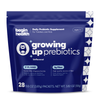Your Cart is Empty
Continue shoppingThe Role of Prebiotics in Supporting Kids with ASD
Expert reviewed by Lauren Mahesri, RDN | Published January 24, 2025
share this article

Autism Spectrum Disorder (ASD) is a complex developmental disability that affects 1 in 59 children in the US (1). Kids with ASD can have behavioral, social, and communication issues.
Beyond the neurological impact, research shows that 50% of kids with ASD have gastrointestinal issues like constipation, indigestion, abdominal pain, and diarrhea (2).
These challenges highlight the importance of optimizing digestion to improve the quality of life for kids with autism.
The connection between autism and gut health may be a two-way street - one impacting another. However, prebiotics play a key role in bridging the gap and supporting both.
What Are Prebiotics?
Prebiotics are a type of fiber that act as fuel for the digestive tract’s beneficial bacteria to improve overall gut health.
Beyond feeding gut bacteria to make it flourish, prebiotics become fermented in the gut and turn into Short Chain Fatty Acids (SCFAs). These SCFAs can improve the gut lining, promote regular bowel movements, and reduce inflammation.
Prebiotics like chicory root inulin and Human Milk Oligosaccharide, found inGrowing Up Prebiotics, help nourish Bifidobacteria in the gut (3). This healthy gut bacteria promotes gentler and more comfortable digestion for your little one.
Gut Health and ASD: The Connection
The foundation of autism’s connection to gut health lies in the gut-brain axis, a two-way phone call between the digestive tract and the central nervous system.
They communicate to each other through immune signals, hormones, the vagus nerve, and short-chain fatty acids (the result of digesting prebiotics) (2).
Because of this connection, consistent prebiotic intake in kids with ASD has been shown to (2,4,5):
-
Improve anti-social behavior
-
Reduce abdominal pain
-
Improve stool regularity
-
Improved verbal communication
Overcoming ASD Challenges When Introducing Prebiotics
Kids with ASD often have a two main challenges - behavioral issues that disrupt diet consistency and sensory issues that limit food variety. These factors can both worsen GI symptoms and make it harder to introduce prebiotics.
Although every kiddo with autism different, there are some methods to address these challenges:
Add Prebiotics in Their Preferred Texture
Studies show that most children with autism prefer “low-texture foods” like soft mashes or purees (6). However, other kids desire the sensory stimulation of crunchy foods. The key is to introduce prebiotics in the format that your kiddo enjoys.
-
Soft Sources of Prebiotics
-
Bananas (preferrably less ripe)
-
Mashed or soft beans
-
Avocado
-
Mashed sweet potato
-
Chia seed pudding
-
Crunchy Sources of Prebiotics
-
Apples
-
Almonds
-
Walnuts
-
Sprinkled ground flax onto a preferred crunchy food
-
Puffed quinoa
Use a Prebiotic Supplement
Although whole foods are a priority, the unique challenges of autism might make the conveneience and consistency of supplements especially valuable.
Growing Up Prebiotics uses chicory root inulin and Human Milk Oligosaccharides (HMOs) to effectively nourish the gut and promote regular, softer bowel movements.
Becuase it’s tasteless and textureless, its extremely helpful for those with specific sensory needs. It seemlessly mixes into water, milk, or soft foods for consistent prebiotic benefits.
Improve Gut Health in Other Ways
Prebiotics are not the only way to improve your kiddo’s gut health! There are other evidence based tactics to nourish their digestive system (7):
-
Probtiocs & fermented foods
-
Increasing diet variety
-
Proper hydration
-
Maintain physical activity
Summary
Prebiotics are an effective way to nourish the microbiome and improve the gut-brain communication pathway. This can result in positive benefits for kids with autism such as reduced gastrointestinal issues and improved behavioral function.
As always, speak with your child’s pediatrician to discuss the best approach for incorporating prebiotics into their lifestyle.

Author
Lauren Mahesri, RDN
Trending

How to Choose a Baby Supplement: What Parents Need to Know
read now
5 Eczema-Safe Recipes That Soothe from the Inside Out (And Your Kids Might Actually Eat)
read now
3 Powerful Strategies to Clear Your Kid’s Eczema for Good
read now






